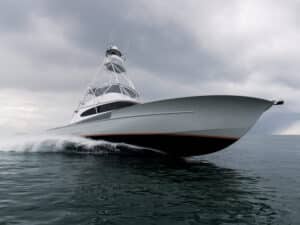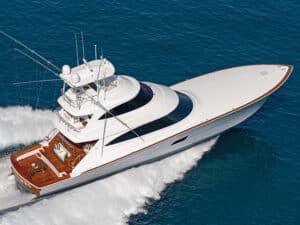
Boston Whaler has always enjoyed a reputation for building some of the finest small boats in the world. For 1999 the company decided to stretch the model line upward to include a new 34-foot express called the Defiance.
Somewhere along the way, Whaler discovered that you can’t build big boats the same way you build smaller boats, even if the smaller vessels are famous for strength and being unsinkable. The 34 Defiance uses all AME 1000 vinylester resins, knitted biaxial fiberglass and Armorcoat gelcoats. Perhaps the greatest construction difference involves the way Whaler now bonds the liner to the hull between each stringer with an adhesive putty called Plexus. This bonding prevents the weight of the engines and liner from compressing the famous Boston Whaler foam, ultimately making the Defiance 34 just as unsinkable as its smaller siblings.
One of the most innovative features on this 34 consists of engine-room access. Most expresses lift the deck up from the aft end using electric or hydraulic rams. However, as Boston Whaler’s director of product development, Scott Wood says, “that limits your headroom on the forward end while making it virtually impossible for the helmsman to drive with the hatch open or for anyone to go below to get parts.” Whaler’s solution rolls the entire deck aft, keeping it level. This not only provides headroom throughout the compartment but also allows access to both the cabin and helm with the engine compartments completely open.
It may not be sexy or a “hit-you-between-the-eyes” marketing tool, but another notable aspect of the Defiance can be found at the transom. Boston Whaler adopted Von Widmann Designs’ EcoSound exhaust system. It exhausts through one set of ports (above the waterline) at slow speed and another (below the waterline) at cruising speed. The system – an Innovation Award finalist two years ago at IMTEC, where it was introduced – has proved to be one of the quietest and cleanest exhausts available today. It also reduces engine exhaust back pressure to almost zero, improving performance and engine longevity.
In the cockpit, pods at the forward end contain an insulated cooler to port, a freezer to starboard and a rigging station outboard of that. Both pods sport aft-facing seats so the crew can mind the trolling pattern in comfort. You’ll also find plenty of rod storage around the cockpit, with three rod holders in each gunwale, space for three more under each gunwale, as well as five rocket launchers along the hard top.
The centerline helm provides plenty of space for flush-mounting electronics and a clear view of the magnetic compass. A comfortable helm seat that can be height-adjusted also has a shock absorber built in. Mirror-image settees to port and starboard on the bridge deck seat two or three passengers per side, and each has a seat back at the aft end as well as copious storage inside.
Down below, Whaler uses a teak-and-holly sole to complement its cabinetry made from maple, a wood you rarely find aboard boats. It’s darker than the commonly used ash and much lighter than teak. It’s a nice change. A dinette converts into a small double berth and the huge athwartship queen berth in the forepeak will fit most NBA pros.
Lots of attention has been paid to the details. There’s even a hanging locker right as you descend the salon stairs you can hang your wet foul-weather gear so as not to drip all over the cabin.







